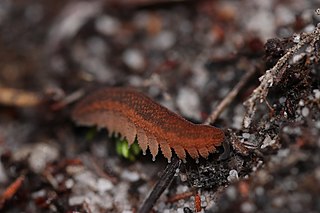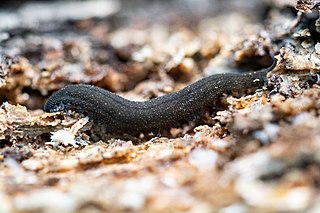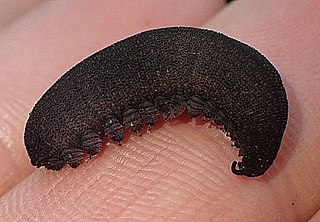The pink velvet worm is a species of velvet worm in the Peripatopsidae family. It is known only from Weza Forest, a Mistbelt Forest in South Africa. Opisthopatus roseus has been found on the forest floor amongst leaf litter, beneath, and within fallen logs.
Opisthopatus is a genus of South African velvet worms in the family Peripatopsidae. They give birth to live young.

Peripatopsis is a genus of South African velvet worms in the Peripatopsidae family. Velvet worms in this family feature a last pair of legs that is rudimentary or reduced in size.

Leucopatus is a genus of velvet worm in the family Peripatopsidae, containing a single species, the blind velvet worm. It is found in northeast Tasmania, Australia, and is ovoviviparous.

Peripatopsidae is one of the two living velvet worm families.

Occiperipatoides is a monospecific genus of velvet worm containing the single species Occiperipatoides gilesii. This genus is ovoviviparous and found in Western Australia. The genus is part of the ancient phylum Onychophora that contains soft-bodied, many-legged relatives of arthropods known commonly as velvet worms.
Cephalofovea is a genus of velvet worms in the Peripatopsidae family. All species in this genus are ovoviviparous and have 15 pairs of oncopods (legs), and both sexes possess a pitted-head which the male everts and uses to pass his spermatophore to the female. They are found in New South Wales, Australia.

Ooperipatellus is a genus of Australian and New Zealand velvet worms in the Peripatopsidae family. Species in this genus are oviparous. Velvet worms in this genus are among the smallest known, with adults often only 10 to 20 millimeters long. Morphological and molecular data indicate that this genus is a monophyletic group.
Opisthopatus cinctipes is a species of velvet worm in the Peripatopsidae family. This species has 16 pairs of legs, all with claws and all used for walking. The type locality is in South Africa.

Tasmanipatus barretti, the giant velvet worm, is a species of velvet worm in the Peripatopsidae family. It is the sole species in the genus Tasmanipatus and is ovoviviparous.
Cephalofovea tomahmontis is a species of velvet worm in the Peripatopsidae family. This species is ovoviviparous, has 15 pairs of oncopods (legs), and lives in rotting logs and leaf litter. The type locality is Mount Tomah, New South Wales, Australia, after which this species is named. Like all members of the genus Cephalofovea, both sexes of C. tomahmontis have a furrow on the head, between the antennae, which the male everts to carry his spermatophore to the female.
Ooperipatellus decoratus is a species of velvet worm in the family Peripatopsidae. It is found in Tasmania, Australia.

Peripatopsis lawrencei is a species of velvet worm in the Peripatopsidae family. This species has 18 pairs of legs: 17 pregenital leg pairs plus one last pair that is strongly reduced and without claws or spinous pads. This species is restricted to the Theewaterskloof-Overstrand region of South Africa.

Peripatopsis moseleyi is a species of velvet worm in the Peripatopsidae family. Females of this species have 19 to 23 pairs of legs with claws ; males have 20 to 24 pairs of legs with claws. The type locality is in South Africa.
Peripatopsis sedgwicki is a species of velvet worm in the Peripatopsidae family. This species can have either 20 or 21 pairs of legs, but descriptions usually report 20 pairs of clawed legs. The type locality is in South Africa.

The Overberg velvet worm is a species of velvet worm in the Peripatopsidae family. This species usually has 19 pairs of legs: 18 pregenital leg pairs plus one last pair that is strongly reduced and without claws or spinous pads. Some specimens, however, have only 18 leg pairs. This species is limited to the Overberg region of South Africa.

Peripatopsis alba, the white cave velvet worm, is a species of velvet worm in the family Peripatopsidae. This species has 18 pairs of legs, with the last pair reduced, and no eyes.

The Knysna velvet worm is a species of velvet worm in the Peripatopsidae family. This species has 17 pairs of legs with claws, with the last pair of legs reduced. Peripatopsis clavigera is found in subtropical or tropical moist montane forests of South Africa.
Diemenipatus mesibovi is a species of viviparous velvet worm in the family Peripatopsidae. The type locality is in Tasmania.
Diemenipatus taiti is a species of viviparous velvet worm in the family Peripatopsidae. The type locality is in Tasmania.










